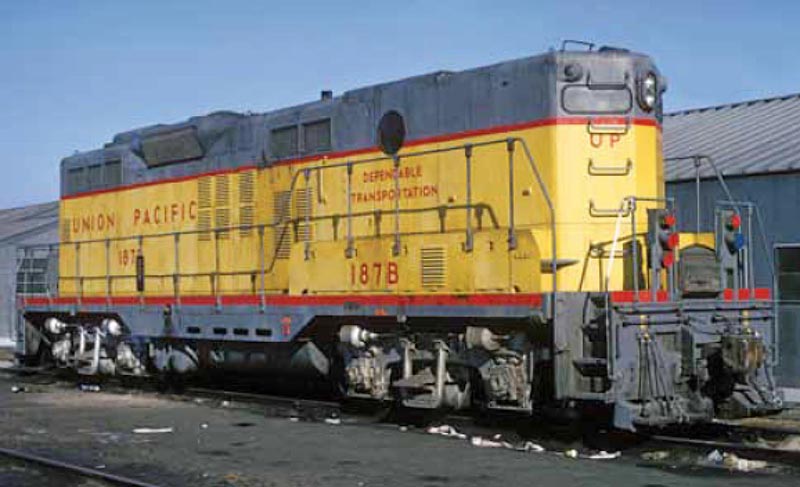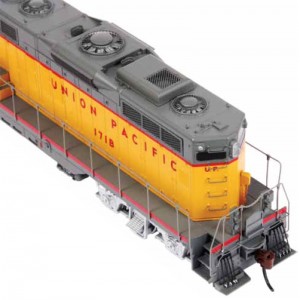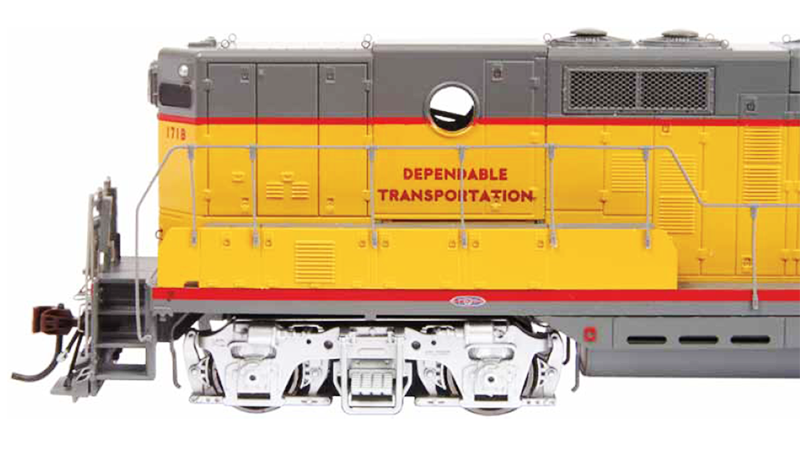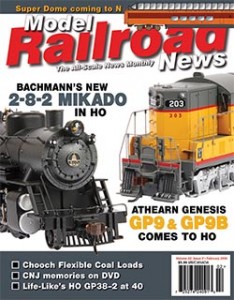Since late 2011, Athearn has been delivering what many HO-scale enthusiasts feel are the ultimate GP7/GP9 renderings to date. These Genesis-series models endeavor to reproduce all the various detail aspects surrounding the early Electro-Motive Division (EMD) Geeps’ production phases, re-buildings, and road-specific attributes exhibited over their impressively long lifespan. Recently the model manufacturer outshopped yet another batch of these highly sought after 1:87 locomotives featuring GP7s and GP9Rs employed by Chicago & North Western (C&NW), as well as GP9s on the rosters of Union Pacific (UP) and Pennsylvania Railroad, including a newly tooled cabless GP9B, which was unique to these latter two roads. The focus of this review will be on UP’s Phase Ia GP9s as they appeared in service during the 1960s.
EMD’s Ugly Duckling
Electro-Motive Division designer Dick Dilworth was the man mostly responsible for developing a diesel locomotive with greater versatility than found in either EMD yard or road locomotives already in use on railroads by the late 1940s. Alco hit upon the idea of an all-purpose locomotive back before the Second World War with its 1,000-hp road switcher known as the RS-1. It provided good visibility for switching duties, yet rode on AAR Type B road trucks, making it usable on the main line while also having the capacity to carry a steam generator for passenger train service. Likewise, Dilworth set out to develop a multipurpose locomotive with similar traits but with higher horsepower.

Another member of the EMD class of 1954, UP No. 182 is pictured at an unknown location in 1968. Displaying basically the same details and paint scheme as Athearn’s new HO-scale Union Pacific releases, number 182 would serve until June 1982, at which time it was scrapped by the railroad in Omaha, Neb.
First of all, the new model would not be a streamlined beauty like EMD’s F- and E-unit diesels, but rather ugly in form, suggesting functionalism and practicality above all else. The carbody would be fashioned so that the engineer could see clearly whether going forward or in reverse, and the crew would have easy access to the mechanical systems, keeping maintenance down time to a minimum. Secondly, it would be equipped with sufficient horsepower for the greatest usefulness. In other words, the locomotive could be used on the main line in multiple units, assigned to branch line duties when required, or just as easily handed over to a yardmaster for switching assignments. Dilworth summed this all up in the model designation for the new EMD diesel: the GP, meaning General Purpose.
After a short-lived and underperforming sales entry hybrid between the F-unit and Geep with 1947’s BL2, EMD changed the face of dieseldom with its debut of the 1,500-hp GP7. More than 2,700 of these locomotives were sold to 74 railroads, including five cabless booster units through late 1954. Because of its popularity, the GP7 can be partially blamed for the demise of the steam locomotive.
EMD then redesigned the 567B V-16 prime mover used in the GP7 and squeezed another 250 hp out of it. This 567C engine variant accompanied the new 1,750-hp GP9 model first delivered in January 1954. This Geep, which changed little from the GP7 in general appearance and size, proved to be an even more popular locomotive than its predecessor, selling more than 4,000 units by the time the GP9 production line was shut down in November 1960; the GP18 superseded it. Visually, the most obvious detail difference between the two first-generation brothers are the number of 10 louvered vents located beneath the cab on the battery storage hatches; the GP7 has three sets, and the GP9 has one set.

GP9B UP No. 187B was found idling on a cold winter’s day at Council Bluffs, Iowa, in December 1972. It still displays the “Dependable Transportation” slogan but wears a slightly compressed rendition of “UNION PACIFIC” along the sides of its long hood.
These early four–axle General Purpose locomotives were in high demand for most of their production lives as railroads rushed to finish the changeover from steam to diesel. New Geeps were turned out at an average rate of two and a half units per day at the EMD plants in La Grange, Cleveland, and by the General Motors Diesel Division (GMD) in London, Ontario. These early Geep brothers certainly made a lasting impression on the industry — a few still served on the big Class I railroads through the turn of the century, some 50 years after the first model rolled off EMD’s assembly line.
Athearn Genesis UP Geep and Beep
First of all, while Athearn is continuously piquing the interests of diesel locomotive aficionados with its seemingly endless array of modifications and enhancements to its GP7/GP9 carbody tooling, the cabless GP9Bs are certainly a standout. Long awaited for by HO-scale railroaders, this particular project represents the fleet of 165 cabless Geeps constructed by EMD at the request of the UP (125 units numbered 130B–204B, 300B–349B) and the Pennsy (40 units numbered 7175B–7204B and 7230B–7239B). As it was so often the practice to utilize multiple units in a single lash-up, the omission of an operator’s cab was believed to be a cost savings, although GP9Bs still maintained hostler controls and porthole side windows for the occasional independent maneuvering of units at engine terminals and in yards. Perhaps the economic efficiencies were never realized with such an arrangement, though, since the practice never really caught on with most roads. UP, in particular, continued to experiment with and advance the concept of the cabless booster through the end of the 20th century.
With that said, Athearn is also providing its new powered UP GP9Bs, numbers 171B and 203B, with a couple of cab units to potentially create a pair of Digital Command Control (DCC) sound-equipped dynamic duos. Numbers 171 and 203 are being offered and, like their cabless counterparts, exhibit the characteristics of Phase Ia production models but with a bit of a twist. Both Geep and Beep came from a group of 75 GP9s, numbers 130–204, and 75 GP9Bs, numbers 130B–204B, delivered by EMD between February and April 1954.
Now, to start with, production phases can often be quite confusing. Diesel expert Scott Chatfield offered a description of the phases, in simplest terms, as far as the GP9 is concerned. Phase Ia maintained the pipe-formed handrail stanchions, generator compartment door vent arrangement (short doors behind the cab), and 36-inch diameter rooftop cooling fans as used on the GP7 while adding louvered vents to the first two full-height engine compartment doors in the long hood. Phase Ib units (beginning in mid-June 1954) were upgraded with new channel-formed handrail stanchions similar to those used on modern diesels.
Phase II production variants (starting in January 1955) generally saw the removal of the lower sets of vents on the generator doors and the addition of louvered vents in the third tall engine compartment door. Phase III GP9s (early 1957) received a new style of fuel tank with shallower side skirts. GP9 models built beginning in October 1957 also typically received larger 48-inch diameter rooftop radiator cooling fans.

Not to complicate things further, though, a quick glance a the Athearn units may have you pondering why if they are Phase Ia GP9s do they then have louvers in their third engine compartment access doors like a Phase II variant? Well, here is the twist to spotting UP units. Apparently, the road’s motive power management determined that the Geeps and Beeps required increased ventilation in the engine section, and within a year or so of delivery, they had their shops replace the original number three solid hood doors with ones now featuring louvered vents. Thus, the Athearn models still display the appropriate Phase Ia attributes, as well as this modification — a good catch by the manufacturer and one we modelers have come to expect on a Genesis-level rendering.
The prototypes of both review models are dynamic brake-equipped samples, UP 203 and 171B, which had long service careers. Typical of UP’s eventual fleet of 324 GP9s, UP 203, built in April 1954 under EMD shop number 19204, worked the rails for nearly 25 years, until being relieved of duty in October 1979. Nine months later, the unit was sold to Naporano Iron & Metal of Newark, New Jersey, and scrapped. UP 171B, on the other hand, took a different path. Delivered in March 1954 under shop number 19247, it was actually retired earlier than its cab-equipped counterpart in July 1976, but that’s when things really get interesting for this Beep. Passed on to Precision National Corporation (PNC) in Mount Vernon, Illinois, a couple of months later, PNC sold the unit to Illinois Central Gulf (ICG), which subsequently rebuilt the unit with full operator’s cab and chopped nose, among other upgrades, and outshopped it as GP10 number 8240 in June 1977. The rebuilt Geep continued on the ICG roster until 1991 and eventually ended up in the hands of the U.S. Army as its number 4610 in March 1992. As last reported by railfans, USA 4610 serves at the McAlester Army Ammunition Plant in McAlester, Okla.
While it has already been established that both Genesis models display a post-delivery appearance after the engine door modification, the Armour Yellow and Harbor Mist Gray paint scheme also tells a story. When delivered, the Geeps carried the “Route of the Streamliners” and “Serves All the West” slogans on the cab sides. In June 1959, however, another cab side slogan was introduced, “Dependable Transportation,” with the delivery of the new SD24s. As the diesel fleet was shopped throughout the early 1960s, they also received this new slogan, which remained in effect until approximately 1972 when “We Can Handle It” became the UP’s latest catch phrase. Therefore, the HO-scale Geep and Beep are best suited for those modeling the 1960s era.
That’s not to say the paint scheme alone should be one’s determining factor for purchasing these models, however. As has been reported with other samples of the GP7/GP9 family in the pages of Model Railroad News over the past four years, the quality of finish and level of detail — not to mention excellent operation — are other factors to consider too. From my experience, these HO renderings are well-researched and possess decoration with an amazing amount of separately applied details garnering excellent model status. The road-specific characteristics are always a seller for me.
 Case in point, I compared MRN’s UP 203 with a photo of the prototype taken in September 1969 and found that, not only did it match the paint scheme, including the appropriate stretched out “UNION PACIFIC” on the long hood sides, but it also matched all the interesting little nuances of this locomotive. These include the canvas-style cab sunshades; the small screen-covered air inlet on the cab roof; the Leslie S-3L-R air horn with clearance bracket offset to the left side of the long hood roof between the first and second radiator fan; a winterization hatch over the third radiator fan; a 1,200-gallon fuel tank; multiple-unit (MU) plug stands; and a speed recorder cable mounted on the front truck. This is not to mention the many standard attributes of the GP7/ GP9 family, the highlights of which are scale-sized hand rails; cooling fans with the proper number of delicate vanes and full fan detail beneath; finely etched grilles; wire grabs and lift rings; detailed pilots; complete air reservoir tank details with condensing lines that are only visible from beneath the model; and even sanding lines run to each wheel. Incredible! Furthermore, UP 171B follows suit with the insert for the GP9B’s porthole windowed cab section well done and accurately matching prototype information as well.
Case in point, I compared MRN’s UP 203 with a photo of the prototype taken in September 1969 and found that, not only did it match the paint scheme, including the appropriate stretched out “UNION PACIFIC” on the long hood sides, but it also matched all the interesting little nuances of this locomotive. These include the canvas-style cab sunshades; the small screen-covered air inlet on the cab roof; the Leslie S-3L-R air horn with clearance bracket offset to the left side of the long hood roof between the first and second radiator fan; a winterization hatch over the third radiator fan; a 1,200-gallon fuel tank; multiple-unit (MU) plug stands; and a speed recorder cable mounted on the front truck. This is not to mention the many standard attributes of the GP7/ GP9 family, the highlights of which are scale-sized hand rails; cooling fans with the proper number of delicate vanes and full fan detail beneath; finely etched grilles; wire grabs and lift rings; detailed pilots; complete air reservoir tank details with condensing lines that are only visible from beneath the model; and even sanding lines run to each wheel. Incredible! Furthermore, UP 171B follows suit with the insert for the GP9B’s porthole windowed cab section well done and accurately matching prototype information as well.
Finally, who is not a fan of the Genesis all-wheel drive system?! The sample models operated super smooth out of the box with an excellent range of scale speeds, as can be seen with the By-The-Numbers data. They are rather lightweight pullers, however, but the duo coupled up together got the job done with a 48-car consist in tow on level track. Of course, the SoundTraxx Tsunami DCC/sound system helped to keep operations in check too, not to mention providing bright directionally controlled lighting and the authentic audio of real Geeps to the test session. DCC-ready non-sound equipped versions of all four UP road numbers are also being offered.
Taking Model Realism to the Highest Level
Athearn touts that its Genesis product line of HO-scale steam and diesel locomotives and rolling stock “take model realism to the highest level.” Believe it. These latest entries into Athearn’s Geep family are fantastic models. So much so that it makes one stop and contemplate if ready-to-run 1:87-size locomotives have reached a plateau; can they really get any better than this?
This review appeared in the February 2016 issue of Model Railroad News
Athearn Trains
1600 Forbes Way Suite 120
Long Beach CA 90810
(310) 763-7140
EMD GP9B diesel locomotive with DCC and SoundTraxx Tsunami sound
Union Pacific 171B, #G62910
MSRP: $289.98
By-The-Numbers
Pull Power (oz. at full slip)
Pull/Loco Weight = Efficiency
1.9/11.2 = 17.0%
DCC Throttle Setting Scale MPH
Min: 2.7
Mid: 40.8
Top: 60.5




